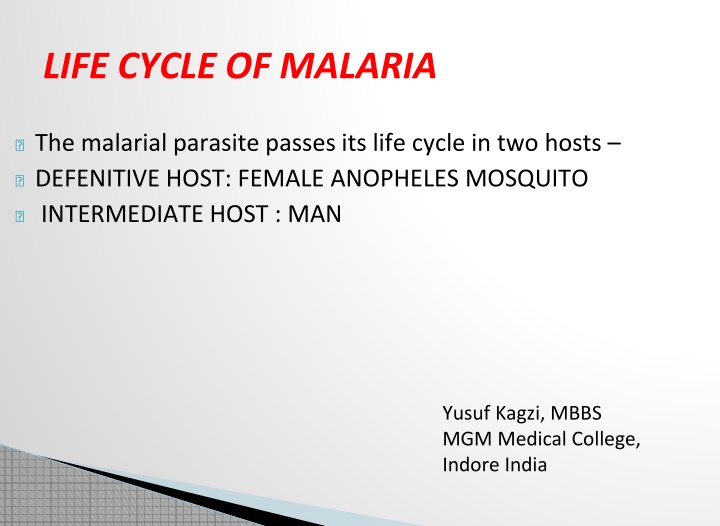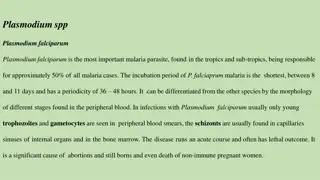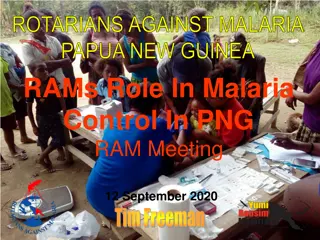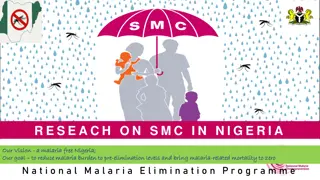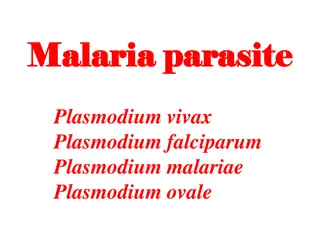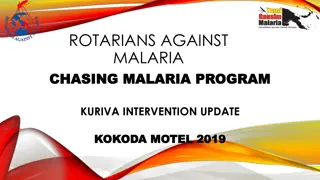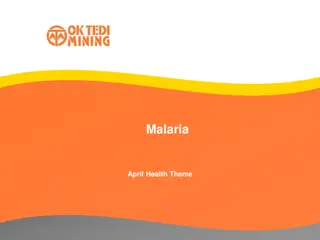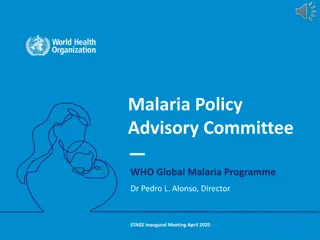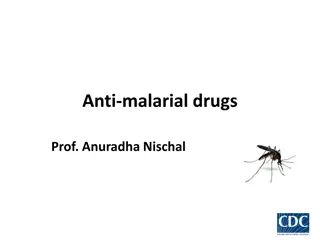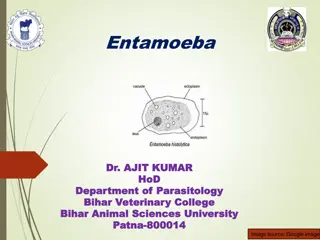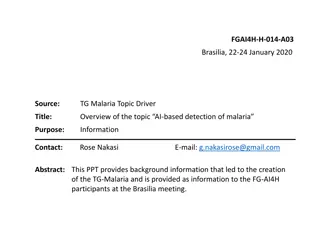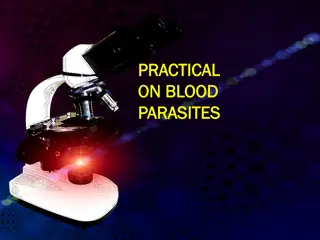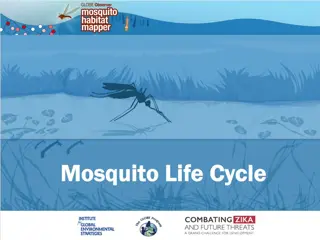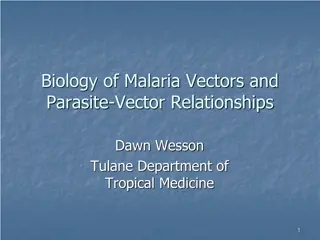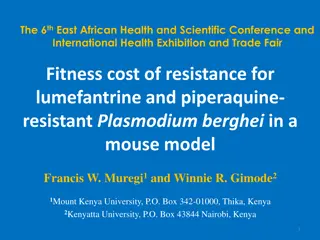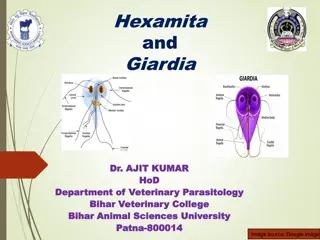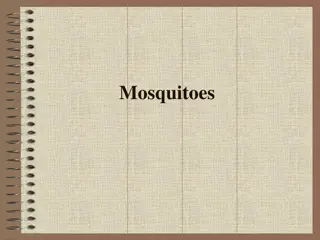Malaria Parasite’s Life Cycle in Humans & Mosquitoes
Malaria, caused by a parasite transmitted through female Anopheles mosquitoes, progresses through a complex life cycle involving both human and mosquito hosts. The asexual development of the parasite occurs in humans, while the sexual development takes place in female Anopheles mosquitoes. Learn about the stages of the malaria parasite’s life cycle and its impact on human health.
Download Presentation

Please find below an Image/Link to download the presentation.
The content on the website is provided AS IS for your information and personal use only. It may not be sold, licensed, or shared on other websites without obtaining consent from the author.If you encounter any issues during the download, it is possible that the publisher has removed the file from their server.
You are allowed to download the files provided on this website for personal or commercial use, subject to the condition that they are used lawfully. All files are the property of their respective owners.
The content on the website is provided AS IS for your information and personal use only. It may not be sold, licensed, or shared on other websites without obtaining consent from the author.
E N D
Presentation Transcript
LIFE CYCLE OF MALARIA ? The malarial parasite passes its life cycle in two hosts ? DEFENITIVE HOST: FEMALE ANOPHELES MOSQUITO ? INTERMEDIATE HOST : MAN Yusuf Kagzi, MBBS MGM Medical College, Indore India
LIFE CYCLE ? ASEXUAL DEVELOPMENT of parasite occurs in man. In this phase ,the malarial parasite multiplies by division or splitting ,a process designated as SCHIZOGONY [schizo to split & gone generation] ? Because this phase occurs in man ,it is also called the vertebrate , intrinsic or endogenous phase. ? SEXUAL DEVELOPMENT takes place in the female Anopheles mosquito ,giving rise to a large number of sporozoites . Hence called SPOROGONY. ? It is also called the invertebrate ,extrinsic ,exogenous phase
HUMAN CYCLE [SCHIZOGONY] Human infection comes through the bite of the infective female Anopheles mosquito. Infective form : sporozoites These sporozoites are present in the salivary gland of the female Anopheles mosquito. These are injected into the blood circulation when the mosquito feeds on blood after piercing the skin. Usually 10-15 sporozoites are injected at a time ,but occasionally , many hundreds may be introduced.
? Human cycle starts and it comprises of the following stages : Pre- erythrocytic schizogony Erythrocytic schizogony Gametogony Exo-erythrocytic schizogony
? 1. Pre-erythrocytic schizogony : Within an hour of being injected into the body by the mosquito , the sporozoites undergo a developmental phase inside the liver cells. ? This phase of development is known as pre-erythrocytic schizogony or merogony. ? The sporozoites which are elongated spindle- shaped bodies , become rounded inside the live parenchymal cells. ? They enlarge in size and undergo multiple nuclear division and develop into schizont.
Mature liver stage schizonts are spherical ,multinucleate and contains 20,000-50,000 uninucleate merozoites. ? The pre-erythrocytic cycle lasts for 8 days in P.vivax 6 days in P.falciparum 13-16 days in P.malariae 9 days in P.ovale ? After completion of this cycle , the liver cells rupture and release merozoites into the blood stream.
? 2.Erythrocytic schizogony: The merozoites released by pre- erythrocytic schizonts penetrate the red blood cells. ? The receptor for merozoites is glycophorin, which is a major glycoproteins on the red cells. The differences in the glycophorins of RBCs of different species may account for the species specificity of malarial parasites. ? Merozoites are pear-shaped bodies ,possessing an apical complex[rhoptery].They attach to the erythrocytes by their apex and then merozoites lie within an intraerythrocytic parasitophorus vacuole formed by red cell membrane by a process of invagination.
? In the erythrocyte , the merozoite loses its internal organelles and appears as a rounded body having a vacuole in the centre with the cytoplasm pushed to the periphery and the nucleus at one pole. These young parasites are therefore called the ring forms or young trophozoites ? The parasites feeds on the haemoglobin of the erythrocyte . It does not metabolize haemoglobin completely and therefore leaves behind a haematin-globin pigment as residue. ? The malarial pigment released when the parasitized cells rupture is taken up by reticuloendothelial cells
? As the ring form develops , it enlarges in size becoming irregular in shape and shows amoeboid motility. This is called the amoeboid form or late trophozoite form ? When amoeboid form reaches a certain stage of development , its nucleus starts dividing by mitosis followed by a division of cytoplasm to become mature schizonts or meronts. ? A mature schizont contains 8-32 merozoites and hemozoin . The mature schizont bursts releasing the merozoites into the circulation. ? The merozoites invade fresh erythrocytes within which they go through the same process of development .
? This cycle of erythrocytic Schizogony or merogony is repeated sequentially , leading to progressive increase in the parasitemia,till it is arrested by the development of host immune response. ? The rupture of the mature schizont releases large quantities of pyrogens . This is responsible for the febrile paroxysms characterizing malaria. ? The interval between the entry of sporozoites into the host and the earliest manifestation of clinical illness is the Incubation period. ? Prepatent period-this is the time taken from entry of the sporozoites to the first appearance of malaria parasite in peripheral blood
? In P.falciparum , erythrocytic schizogony always takes places inside the capillaries and vascular beds of internal organs. Therefore, in P.falciparum infections, schizonts, and merozoites are usually not seen in the peripheral blood. ? GAMETOGONY: After a few erythrocytic cycles, some of the merozoites that infect RBCs do not proceed to become trophozoites or schizonts but instead, develop into sexually differentiated forms, the gametocytes. ? The female gametocyte is larger (macrogametocytes) and has cytoplasm staining dark blue with a compact small nucleus staining deep red. In the smaller male gametocyte (microgametocyte), the cytoplasm stains pale blue or pink and the nucleus is larger, pale stained and diffuse . Pigment granules are prominent.
? Development of gametocytes generally takes place in the red blood cells of the capillaries of internal organs such as spleen and bone marrow. These are the sexual forms and only mature gametocytes are found in the peripheral blood. ? Female gametocytes are generally more numerous than the male. ? The mature gametocytes are round in shape except in P.falciparum in which they are crescent-shaped. ? Gametocyte appear in circulation 4-5 days after the first appearance of asexual form in case of P.vivax and 10-12 days in P.falciparum ? A person with gametocytes in blood is a carrier or reservoir. ? The gametocytes do not cause any clinical illness in the host, but are essential for transmission of the infection. ? A gametocyte concentration of 12 or more per cumm of blood in the human host is necessary for mosquitoes to become infected.
? 4. EXOERYTHROCYTIC SCHIZOGONY : The exoerythrocytic cycle resembles the pre-erythrocytic cycle. ? In case of P. vivax and P.ovale infections ,some sporozoites on entering into liver cells,do not undergo asexual multiplication but enter into a resting (dormant) phase . The resting stage of the parasite is known as hypnozoite. It is rounded, uninucleate. After some period (usually up to 2 years) hypnozoites reactivate to become schizonts and release merozoites. These merozoites attack RBC and are responsible for relapse of malaria. ? Exo-erythrocytic schizogony is absent in P.falciparum and P.malariae, therefore, relapses do not occur in malaria caused by P.falciparum and P.malariae
